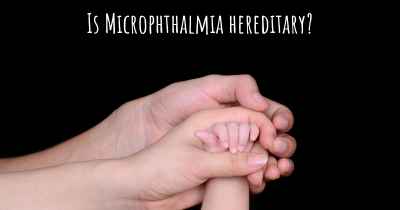Living with Microphthalmia. How to live with Microphthalmia?
Can you be happy living with Microphthalmia? What do you have to do to be happy with Microphthalmia? Living with Microphthalmia can be difficult, but you have to fight to try to be happy. Have a look at things that other people have done to be happy with Microphthalmia

Living with Microphthalmia
Microphthalmia is a condition characterized by abnormally small eyes. It can affect one or both eyes and may occur as a result of genetic factors, prenatal infections, or other underlying conditions. Living with microphthalmia can present unique challenges, but with the right support and strategies, individuals with this condition can lead fulfilling lives.
1. Seek Medical Care and Support
If you or your child has been diagnosed with microphthalmia, it is crucial to seek medical care from a qualified ophthalmologist or eye specialist. They can provide a comprehensive evaluation, determine the severity of the condition, and recommend appropriate treatment options. Regular check-ups and follow-ups are essential to monitor eye health and address any potential complications.
Additionally, connecting with support groups or organizations specializing in microphthalmia can be immensely helpful. These communities provide a platform to share experiences, gain knowledge, and find emotional support from others who understand the challenges associated with the condition.
2. Educate Yourself
Learning about microphthalmia and its implications can empower you to make informed decisions and advocate for yourself or your child. Research reputable sources, such as medical journals, books, and reliable websites, to understand the causes, treatment options, and potential visual impairments associated with microphthalmia. Knowledge is a powerful tool in managing the condition effectively.
3. Visual Aids and Assistive Technology
Depending on the severity of microphthalmia and associated visual impairments, visual aids and assistive technology can significantly enhance daily life. Consult with an optometrist or low vision specialist who can recommend appropriate visual aids, such as magnifiers, telescopic lenses, or electronic devices, to improve visual functioning. These tools can assist with reading, writing, and other activities that may be challenging due to reduced vision.
4. Early Intervention and Rehabilitation
For individuals with microphthalmia, early intervention and rehabilitation services are crucial. These services can include vision therapy, occupational therapy, and orientation and mobility training. Early intervention programs aim to optimize visual functioning, enhance motor skills, and promote independence in daily activities. Working with a team of professionals can help develop strategies to overcome challenges and maximize potential.
5. Emotional Support and Self-Care
Living with microphthalmia can sometimes lead to emotional challenges, such as low self-esteem, frustration, or anxiety. It is essential to prioritize self-care and seek emotional support when needed. Engage in activities that bring joy and boost self-confidence. Surround yourself with a supportive network of family, friends, or professionals who can provide encouragement and understanding.
6. Accessibility and Accommodations
Ensure that your living and working environments are accessible and accommodate your specific needs. This may include modifying lighting conditions, using contrasting colors, or implementing assistive technologies. Advocate for necessary accommodations at school or in the workplace to ensure equal opportunities and a conducive environment for learning or working.
7. Celebrate Individuality and Achievements
Remember that microphthalmia does not define you or your worth. Celebrate your individuality and focus on your strengths and achievements. Set realistic goals and celebrate milestones along the way. Surround yourself with positive influences and engage in activities that promote personal growth and fulfillment.
Living with microphthalmia may present challenges, but with the right support, resources, and mindset, individuals can lead fulfilling lives. Remember to seek medical care, educate yourself, utilize visual aids, engage in early intervention and rehabilitation, prioritize self-care, advocate for accessibility, and celebrate your individuality. Embrace your unique journey and never hesitate to reach out for support when needed.








